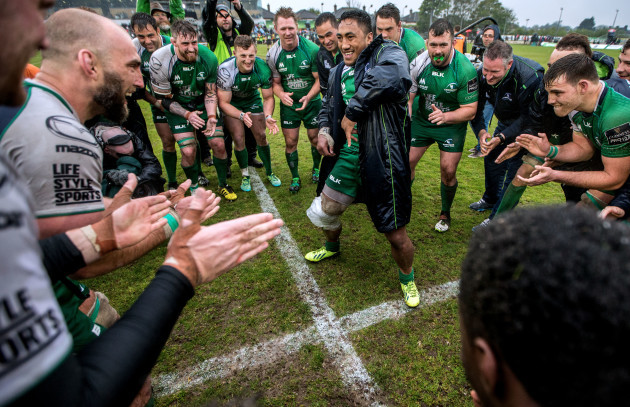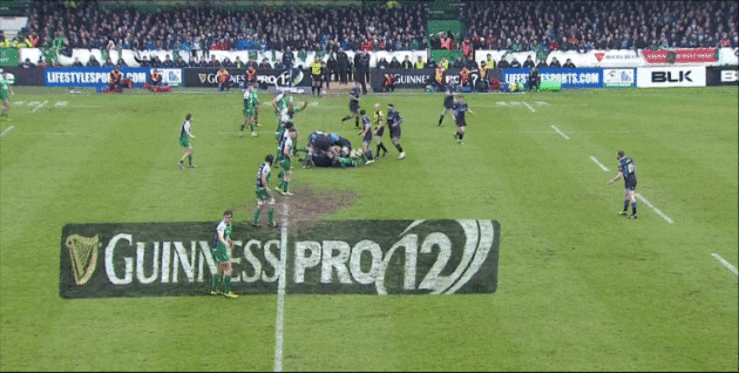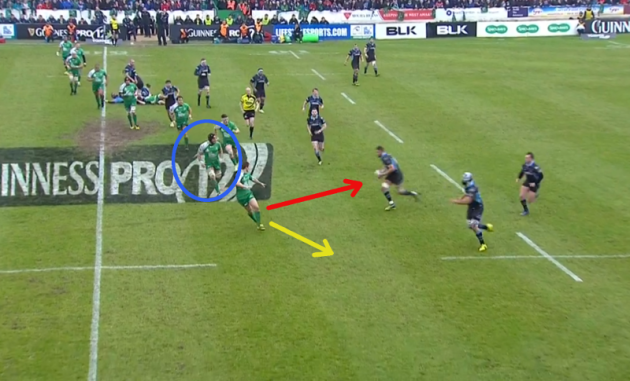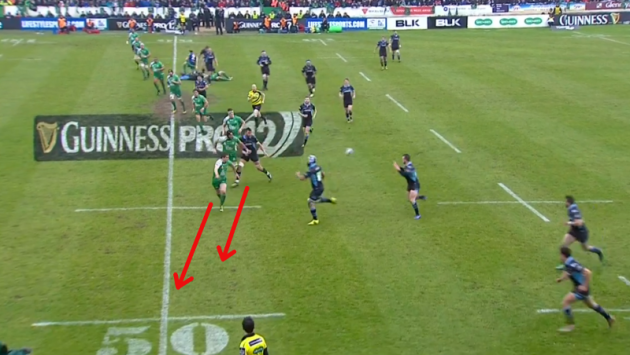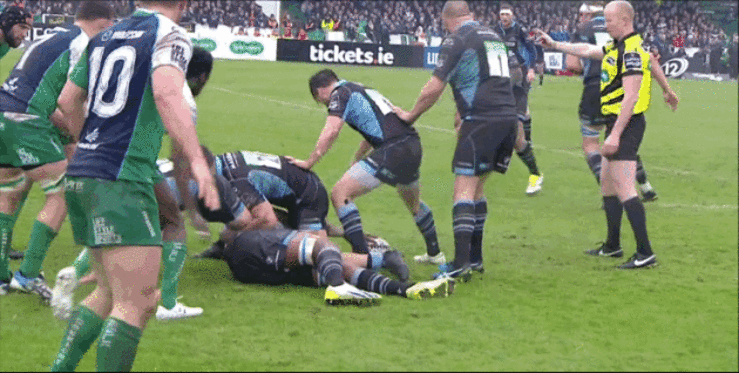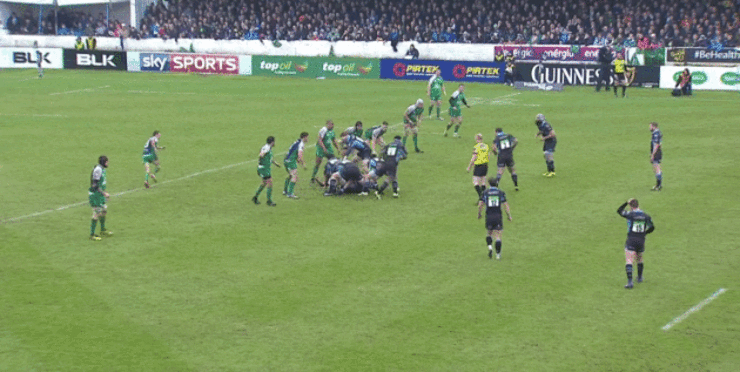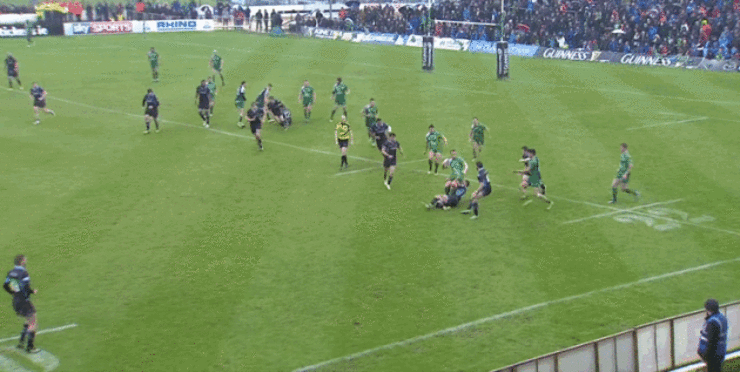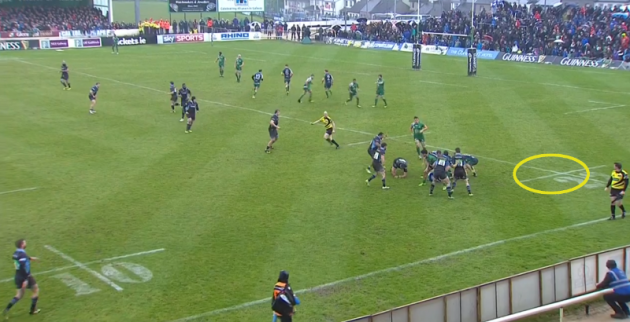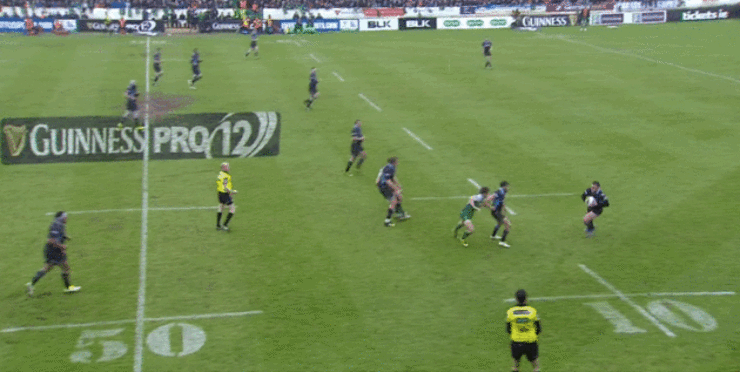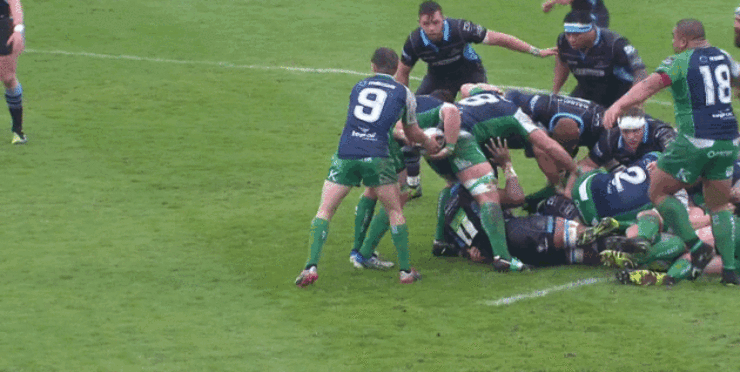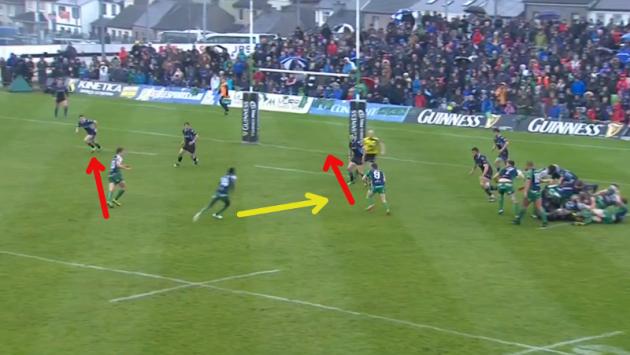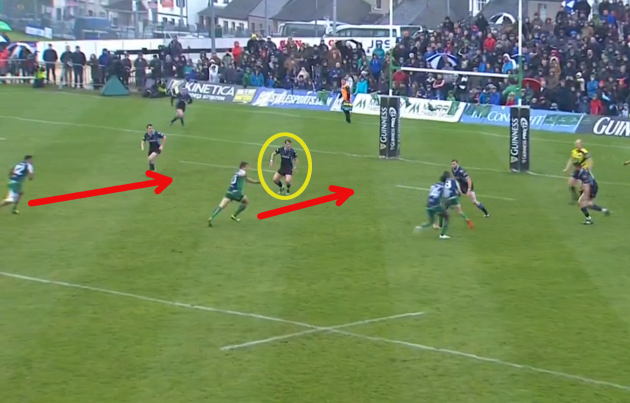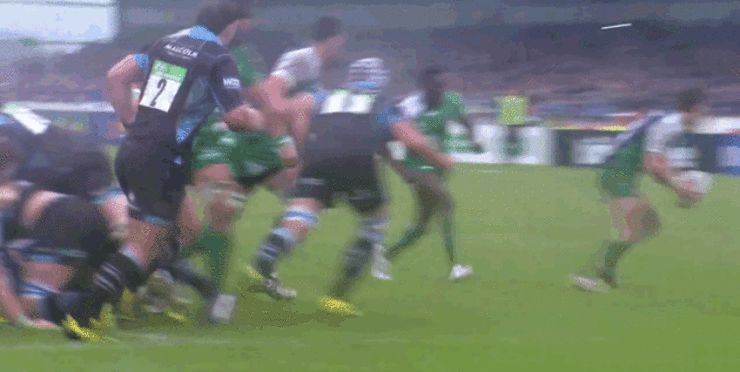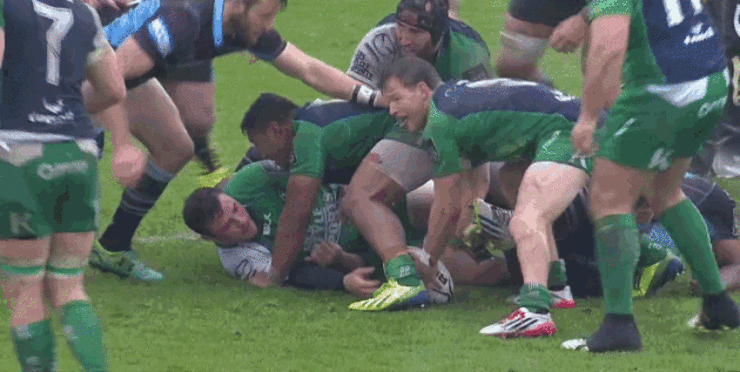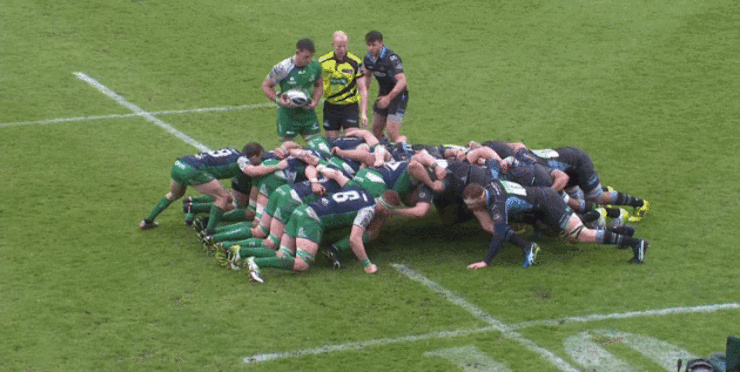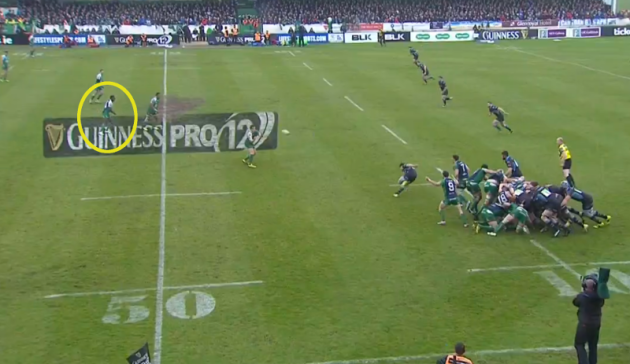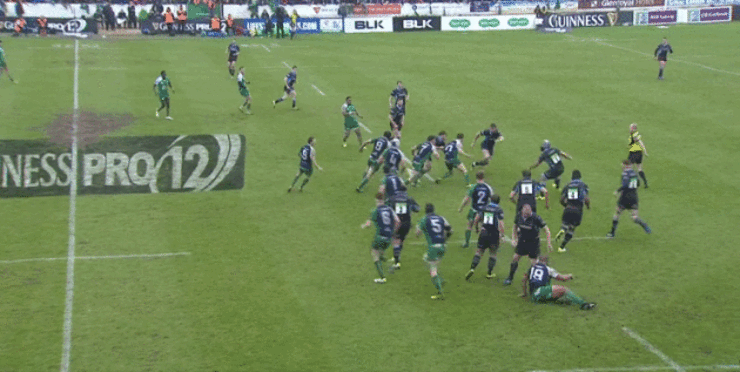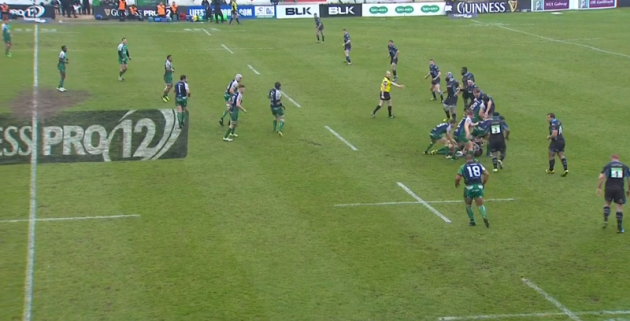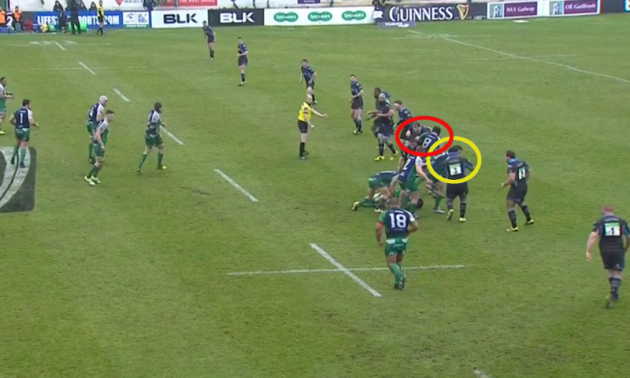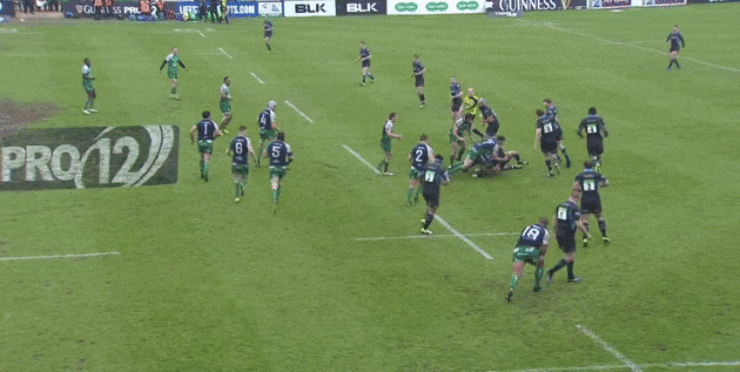WHILE THE WEATHER conditions meant Connacht’s clash with Glasgow on Saturday was never likely to be free-flowing, Pat Lam’s men were involved in an absorbing encounter that tantalisingly set up the Guinness Pro12 semi-final between these sides.
A wet ball ensured that both teams struggled to hit the attacking peaks they are capable of, but there were some moments of class from the western province.
Meanwhile, Connacht’s defence offered the latest encouraging signs of the desire and work rate that has driven their magnificent season.
If defence is the greatest illustration of a squad’s off-field culture and togetherness, as many coaches believe it is, then Connacht are in a good place.
Only in the 7-6 win over Leinster in March have Connacht conceded fewer points in a Pro12 game this season than the seven they limited Glasgow to at the Sportsground.
If the sun shines in Galway in two weekends time for the semi-final meeting between Connacht and Glasgow, and even if it doesn’t, Gregor Townsend’s men are likely to provide a more stern test of the westerners’ defensive ability, but this was a solid foundation.
On a slippery, messy day at the Sportsground, Connacht drew on some of the most basic tenets of rugby – aggression, work rate and pure desire to win – to attack the Scots without the ball.
Chat
Connacht actually started the game with a defensive error, as Leone Nakarawa took advantage of a loss of concentration from the home team and burst right through the middle of a ruck.
Indeed, Connacht took some time to find their feet in terms of linespeed, but we did see early signs of the communication that proved vital to their success.
Connacht find themselves numbers down on the right-hand side of the defensive ruck above, although a poor pass from Glasgow scrum-half Ali Price aids their cause.
Finn Russell shifts the ball on out the line to Ryan Wilson and already there’s a slight stress on the narrow Connacht defence.
In the moment below, there’s already a temptation for Aj MacGinty to bite back inside on Wilson, as indicated with the red arrow. This would, of course, be catastrophic for Connacht’s defence with four further Glasgow attackers outside Wilson.
Instead, MacGinty gets the all-important communication from John Muldoon [blue circle] that the number eight has Wilson covered and is able to drift, as indicated by the yellow line below.
Just as importantly, Muldoon stays alive in the defensive line after Wilson passes. He resists any temptation to switch off after the ball is moved on, understanding that Glasgow still have numbers holding the width.
Muldoon maintains his hard drift inside MacGinty, meaning that even when the out-half slips as Stuart Hogg cuts a line back inside, the Connacht number eight is in position to cover the situation.
Josh Strauss obstructs Muldoon’s attempt to halt Hogg and Connacht pick up the penalty.
This example underlines the uncharacteristic lack of accuracy Glasgow brought in attack on Saturday, but it also serves to demonstrate Connacht’s strong communication and work rate at the Sportsground.
In a numbers-down defensive scenario, the basics ensure that Connacht get a positive result.
Bringing the pain
Equally as important in Connacht’s defensive effort on Saturday was their pure aggression in contact.
With a best-ever season and their primary goal already achieved, perhaps the easy thing for Connacht to do at this stage would be to ease off. That thought clearly hasn’t been entertained by these players for a second.
Ultan Dillane is well established as a hitting machine, and he underlined that status with a number of crunching tackles against Glasgow.
In the instance above, what impresses most is Dillane’s height as he enters the tackle. Having read the tip-on pass from Sila Puafisi, it would have been understandable for the Connacht lock to smash high into Fraser Brown’s upper body.
What makes his tackle effective, however, is the manner in which he drives his shoulder into the Glasgow hooker at roughly hip height, knocking him straight to deck with a concurrent lift of the left leg.
Rob Harley dives off his feet in his desperate rucking attempt as a result.
Above it’s Bundee Aki who hammers up for Connacht, while it’s Sean O’Brien in the example below, which comes on the very next phase.
Connacht were queuing up to make hits on Glasgow ball carriers throughout the game and made particular gains when Townsend’s men played one pass out from the ruck.
Passing quality and range were naturally reduced in the poor conditions and that meant Glasgow’s attacking palate was also affected. Connacht backed themselves to blitz up hard on the ball carriers close to the ruck and invariably delivered big hits.
The red card for Puafisi in the second half gave Connacht a numerical advantage, of course, but nilling the visitors in the opening 40 minutes – even with a handful of imperfections and linebreaks – was an achievement.
Kick routine
In contrast to many of their recent performances, Connacht kicked out of their own half frequently against the Glaswegians as they sought territory and asked the visitors to play from deep.
In poor conditions on Saturday, that was sensible but any repeat in the semi-final would be incredibly costly for Connacht.
We get an example in the case above, as Kieran Marmion launches a clearing box kick immediately after Connacht have carried out to the wide left channel.
There are no viable chasers on their feet for Connacht in this instance, apart from Jake Heenan – who is just ahead of Marmion as he kicks.
‘Exit strategies’ aren’t just about kicking the ball out of dangerous positions, but building favourable scenarios from which to launch those kicks or passes. One of the key pillars is generally ensuring any kick comes with ample opportunity for chasers to follow up.
That’s why we often see teams taking on extra phases deep in their half that can appear meaningless. Those additional carries allow wings to get into position to chase the subsequent kick from their halfback.
As we see above, Connacht don’t have a chaser in position on that left-hand side of their ruck and when that’s combined with a sub-four second box from Marmion [four seconds or over is generally the target here], Russell can claim the ball with ease.
He shifts it infield to Stuart Hogg and suddenly there’s danger for Connacht. Typically of this Glasgow display, the fullback knocks the ball on as he attacks in this instance, but the message is quite clear.
Any repeat of these habits against Glasgow in the semi-finals will be punished. If conditions are better, it’s unlikely that Connacht will kick as much, but they will need to do so with greater accuracy and organisation.
Finding the finish
Scoring two tries to Glasgow’s one on Saturday reflected the fact that Connacht showed a little more of a clinical edge in their attack compared to Townsend’s side, even if Lam will have been frustrated by several missed opportunities.
Connacht appeared to set a promising tone with their first genuine visit to the Glasgow 22, coming away with seven points.
It was some typical defensive doggedness that allowed Connacht to gain good field position for the score, with MacGinty working hard to ground Hogg and allow Jake Heenan to jackal over the ball.
The Connacht out-half finds himself obstructed by Price as he tracks Hogg, but fights determinedly to dive low into the tackle, trapping the Scotland international’s right ankle and inviting Heenan to swoop for the turnover, one of many Connacht earned against Glasgow.
The penalty ensues and a defensive action is turned into superb territory, 10 metres out from the Glasgow tryline.
Connacht attempt to maul their way over, but are halted and instead play away to the left to fantastic effect.
The running lines of Marmion and MacGinty are diagonally towards the left touchline at first, with Niyi Adeolokun providing the counter on a switch line under the scrum-half to interest pillar defender Wilson.
Marmion’s arcing line now means that Glasgow out-half Russell has to commit inwards to the Ireland international, at exactly the point MacGinty straightens on Marmion’s left shoulder.
As we see below, that change of line from MacGinty as Russell commits to Marmion means that Peter Horne [yellow circle] is just slightly too wide of MacGinty, who is now ‘his man’.
Outside MacGinty, inside centre Bundee Aki has also straightened up to burst into the hole on Horne’s right shoulder.
Horne has to commit to tackling MacGinty as Marmion releases a short pass, but that initial change of line by MacGinty means that Horne is now reacting inwards to the tackle and can’t get a dominant shot on.
MacGinty has the major advantage in the collision and can get his hands clear through the tackle to find Aki.
In truth, not too many players would score in this case but we’ve seen before that Aki is a special physical specimen.
Many of Connacht’s tries and performances this season have been down to their attacking intelligence and organisation, but this showing was more about their aggression and desire.
Aki illustrates that with his explosive finish, bursting into the passive tackle of Wilson and Price and finding a clever little one-handed finish to dot the ball down.
There aren’t too many athletes like Aki in Ireland and it’s why he is is almost certain to play for the national team if re-contracted beyond the end of next season.
Connacht’s second score came from a clever cross-field kick by Shane O’Leary – perhaps his trademark move now! – with advantage being played.
With his team now down to 14 men, Hogg has to step up closer to the frontline defence than he might like here and is left backing up in his attempt to claim O’Leary’s kick.
Tiernan O’Halloran is steaming forward onto the ball and rises beautifully, stretching his hands up towards the pill to guide it into his grasp as he comes to deck. Again, a wonderful finish.
Clinical edge required
As ever, there is room for improvement in this Connacht performance and there is a real sense that they will need as much if they are to overcome Glasgow in the semi-final in two weekends’ time.
While Lam’s men finished well in the instances above, there were also a number of frustrating failings in the Glasgow 22.
Just minutes before the O’Halloran try comes the above example, as Connacht’s handling lets them down at the crucial point after some positive build-up play.
The conditions do of course explain some of the deficiencies in this area, but there were also forced and inaccurate offload attempts and passes that could not be explained away by the weather.
If Connacht are to be a champion side, they will need to maintain the consistent finishing composure of winners in the semi-final.
Tricks up their sleeve
One of the most fascinating aspects of watching Connacht this season has been their use of set-piece possession.
Pat Lam and assistant attack coach Conor McPhillips have been extremely intelligent and inventive in producing strike moves and power plays off scrum and lineout, testing the opposition with fresh ideas.
Connacht’s duo of attack coaches are not afraid to think outside the box and it’s certainly one of the ways in which they’ve tested opponents greatly this season.
While several of their best scores have been down to the excellent phase-play shape that we’ve examined before, many tries and linebreaks have also come from set-piece power plays.
Connacht under Lam so often tee up the opposition to be broken, with individuals like Matt Healy, Aki and Marmion being the men to take advantage of the ideas behind the plays.
The sight of openside flanker Heenan in the scrum-half position, with Marmion at number eight, at a scrum in the first half in Galway was rather bizarre.
Firstly it should be pointed out that Marmion is never legally bound to the scrum here, but it’s an interesting tactic nonetheless.
Marmion lines up between ‘openside’ Muldoon and loosehead lock Dillane here, rather than in between the two locks as would be more traditional. His intent is clearly to pass swiftly from the base of the scrum.
He needs the sheltering work of Heenan to get his pass away, but we can see that Glasgow are immediately drifting hard across the pitch from the scrum in order to compensate for the additional width Marmion’s pass has provided.
It’s also worth noting that Connacht right wing Niyi Adeolokun is showing across in midfield. There’s nothing unusual in that, but his positioning is part of the deception Connacht look to build.
As MacGinty carries to the line, we can see Marmion ordering his forwards around the corner, as if he needs them there to carry on the next phase.
It means that as Marmion approaches the ball, every player barring Rodney Ah You – who was driven to deck at the scrum – is either in the ruck or on the left-hand side of it waiting for Marmion’s pass.
Glasgow’s forwards largely respond by folding around to that side of the ruck, leaving only the three front rows as defenders on their left-hand side in the frontline defence.
There’s a clap of the hands from first receiver Aly Muldowney to the left of Marmion, but he knows exactly what’s going to happen next.
As Marmion goes to scoop the ball up, the key men to keep an eye on are Muldoon and Heenan at the front of the breakdown.
Thanks to having started the passage in the scrum-half position, Heenan is first arrival at the breakdown and he then pushes forward to block the possibility of Puafisi getting to Marmion as he bursts forward through the middle.
On Marmion’s left, Muldoon – who started the passage at openside in the scrum and is therefore in position to be second arrival – is performing the same duty in closing off the possibility of Jonny Gray scragging the Connacht scrum-half.
Essentially, Heenan and Muldoon create a passage for Marmion to slip through, as we see below.
Marmion bursts clear and almost sidesteps Lee Jones before offloading to Heenan, who has worked hard to be on the scrum-half’s shoulder.
Connacht are right in behind the scrambling Warriors, but then with numbers up wide on the left Aki uncharacteristically dithers on the ball and throws a poor offload attempt to ground to allow Glasgow to counter.
It’s an unsatisfying result, but the construction of the opportunity with a power play is typically clever from Connacht.
We wait to see what Lam and McPhillips have up their sleeves for the semi-final at the Sportsground on 21 May.
What an evening that promises to be.
The42 is on Snapchat! Tap the button below on your phone to add!
